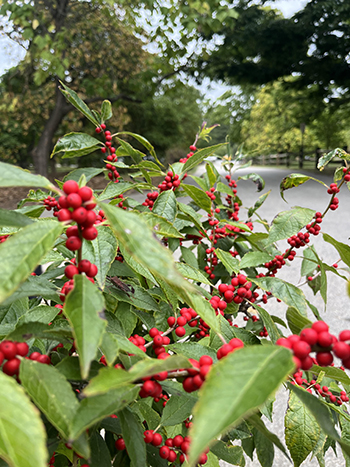
Plants of the Week: September 30
Guest Author: Seamus Lewin, 2024 – 2025 Public Horticulture Intern

Hylotelephium (syn. Sedum) telephium (Atropurpureum Group) ‘Xenox’ (stonecrop)
Situated on the central platform of the sprawling stone stairs on the front of Pearson Hall, you can find Hylotelephium telephium ‘Xenox’, also known as stonecrop. This Hylotelephium, like many others, has fleshly foliage, but uniquely has leaves and flower stems that display a striking purple-brown color. These stems culminate beautifully with dusky pink flowers that deepen in color as they mature.
There are a number of convincing reasons to have this Hylotelephium in your garden that go well beyond its attractive foliage. This Hylotelephium has a wonderfully long season of interest of over six months, lasting from early summer well into the winter. It can thrive in gravelly/sandy soils, is low maintenance, and is quite drought resistant once established. Sedum telephium ‘Xenox’ is also great for attracting pollinators such as bees, hummingbirds, and butterflies.
Hylotelephium telephium (Atropurpureum Group) ’Xenox’ flourishes at the front of a border or in beds with other short plants, enjoying full sun or partial shade. Additionally it is an excellent choice for a patio container.

Symphyotrichum novae-angliae ‘Andenken an Alma Pötschke’ (New England aster)
On your walk through the Terry Shane Teaching Garden take a moment to look for Symphyotrichum novae-angliae ‘Andenken an Alma Pötschke’. This New England aster is right in the midst of its season of interest, from late summer to late fall, and is quite a stunning sight.
This cultivar of New England aster boasts bright, hot-pink flowers and a sunny yellow pistil which is offset by deep green foliage. The flowers cluster at the tips of long, sturdy stems. On cloudy days, these flowers will droop, only to return to their prior beauty when the sun shines again. These qualities are enough to differentiate it from most other plants you might find in the garden.
Asters are a must for those interested in attracting bees and butterflies, while being relatively unpalatable to deer and rabbits. They prefer moist soil, and are an ideal addition as border plants in late summer and fall gardens. Importantly, asters may self seed if they are grown in ideal conditions so be sure to cut back after flowering.

Ilex verticillata (winterberry)
Growing alongside the BioSteam, you can find the bright red berries of Ilex verticillata. Also known as winterberry, this plant is a slow-growing, woody, deciduous shrub. Winterberry is low maintenance, adaptable to dry or moist soils, deer resistant, and attractive to birds.
During summer, this plant has rather inconspicuous flowers, which give way to extremely showy bright red fruit that persist throughout winter. Typical of plants in the holly family, these shrubs are dioecious meaning they are either male or female. Only fertilized female flowers will produce the berries that are the signature of the species. Typically, one male winterberry will be sufficient for pollinating 6-10 female plants.





John Schucker
Posted at 10:26h, 24 OctoberI always enjoy reading these posts and seeing the photos. I think you may not be aware that the photo of the symphyotrichum seems to be missing (the sedum photo appears twice), I thought I would mention it, in case you would like to correct this. The sedum has piqued my interest, especially as we are experiencing this current, worrying drought.